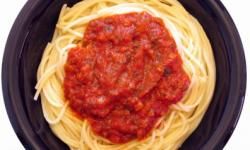 “Follow these steps to remove spaghetti sauce and other food stains.Davide Guglielmo
“Follow these steps to remove spaghetti sauce and other food stains.Davide Guglielmo
Steak, barbeque and spaghetti owe a lot of their delicious flavor to their respective sauces. Follow these stain removal tips to eliminate these tasty toppings from your inedible household surfaces.
The first step in removing food stains is to identify the stained material.
Below are the most common types of materials that can become food-stained, with steps on how to remove food from each:
- Non-washable fibers such as Acetate, Burlap, Carpet (synthetic or wool), Fiberglass, Rayon, Rope, Silk, Triacetate or Wool
- Washable fibers such as Acrylic Fabric, Cotton, Linen, Modacrylic, Nylon, Olefin, Polyester or Spandex
- Hard surfaces such as Acrylic Plastic, Aluminum, Asphalt, Bamboo, Brass, Bronze, Cane, Ceramic Glass/Tile, Chromium, Copper, Cork, Enamel, Glass, Gold, lron, Ivory, Jade, Linoleum, Opal, Paint (flat or gloss), Pearls, Pewter, Platinum, Plexiglass, Polyurethane, Porcelain Dishes, Stainless Steel, Vinyl Clothing, Vinyl Tile or Vinyl Wallcovering
- Stone surfaces such as Alabaster, Bluestone, Concrete, Flagstone, Granite, Limestone, Marble, Masonry Tile, Sandstone, Slate or Terrazzo
- Leather or suede
- Silver
- Wallpaper
- Wood
Contents
- Non-washable Fibers
- Washable Fibers
- Hard Surfaces
- Stone Surfaces
- Leather or Suede
- Silver
- Wallpaper
- Wood
Non-washable Fibers
Follow these steps to remove food stains from Acetate, Burlap, Carpet (synthetic or wool), Fiberglass, Rayon, Rope, Silk, Triacetate, Wool:
- Gently scrape (the method of using a dull tool to gently lift off excess solid or caked-on stains) to remove excess.
- Sponge (the method of using a dampened pad to apply light strokes, moving outward from the center of the stain) the area with a dry-cleaning solvent such as Afta Cleaning Fluid.
- Apply a dry spotter.
- Cover the stain with an absorbent pad dampened with dry spotter.
- Let it stand as long as any stain is being removed.
- Change the pad as it picks up the stain.
- Keep the stain and pad moist with dry spotter.
- When no more stain is being removed, flush (the method of applying stain remover to loosen staining material and residue from stain removers) the area with the dry-cleaning solvent and allow to dry.
- On carpets, sponge with water to remove the enzyme mixture, then place a clean dry pad over the area and weight it down.
- When no more liquid is being absorbed, allow it to air dry completely.
Washable Fibers
Follow these steps to remove food stains from Acrylic Fabric, Cotton, Linen, Modacrylic, Nylon, Olefin, Polyester, Spandex:
- Carefully scrape to remove as much excess as possible.
- Apply a wet spotter and work into the fabric.
- Rinse thoroughly with water and launder.
Hard Surfaces
Follow these steps to remove food stains from Acrylic Plastic, Aluminum, Asphalt, Bamboo, Brass, Bronze, Cane, Ceramic Glass/Tile, Chromium, Copper, Cork, Enamel, Glass, Gold, lron, Ivory, Jade, Linoleum, Opal, Paint (flat or gloss), Pearls, Pewter, Platinum, Plexiglass, Polyurethane, Porcelain Dishes, Stainless Steel, Vinyl Clothing, Vinyl Tile, Vinyl Wallcovering:
Note: The tomato sauce contained in these foods can permanently stain some surfaces.
- Wipe up the excess immediately with a cloth or sponge dipped in warm sudsy water.
- Rinse with clear water and wipe dry.
Stone Surfaces
Follow these steps to remove food stains from Alabaster, Bluestone, Concrete, Flagstone, Granite, Limestone, Marble, Masonry Tile, Sandstone, Slate, Terrazzo:
- Carefully remove the excess spill.
- Wipe stain with a cloth dipped in a solution of washing soda or detergent (not soap) and water.
- If any stain remains, mix a poultice of water, bleach, and powdered detergent.
- Apply to the stained area and cover with a damp cloth to retard evaporation.
- When stain is removed, rinse well and wipe dry with a soft cloth.
Leather or Suede
Follow these steps for removing food stains from leather or suede:
- Mix a solution of mild soap in lukewarm water.
- Swish to create a great volume of suds. Apply only the foam with a sponge.
- Wipe dry with a clean cloth.
- On leather only, follow with cleaners such as Tannery Vintage Leather Cleaner & Conditioner or Fiebing’s Saddle Soap to condition the leather.
Silver
Follow these steps to remove food stains from silver:
- Wash silver immediately in hot soapy water as the acids in these sauces can damage the silver.
- Rinse thoroughly in hot water and wipe dry with a soft cloth to prevent tarnish.
Wallpaper
Follow these steps to remove food stains from wallpaper:
- Wipe immediately with a cloth dampened with clear cool water.
- Use overlapping strokes to prevent streaking.
- Gently pat dry with a soft cloth.
Wood
Follow these steps to remove food stains from wood:
- Wipe immediately with a cloth moistened with warm sudsy water.
- Rinse with a cloth dampened with clear water, wipe dry, and polish or wax as usual.







































